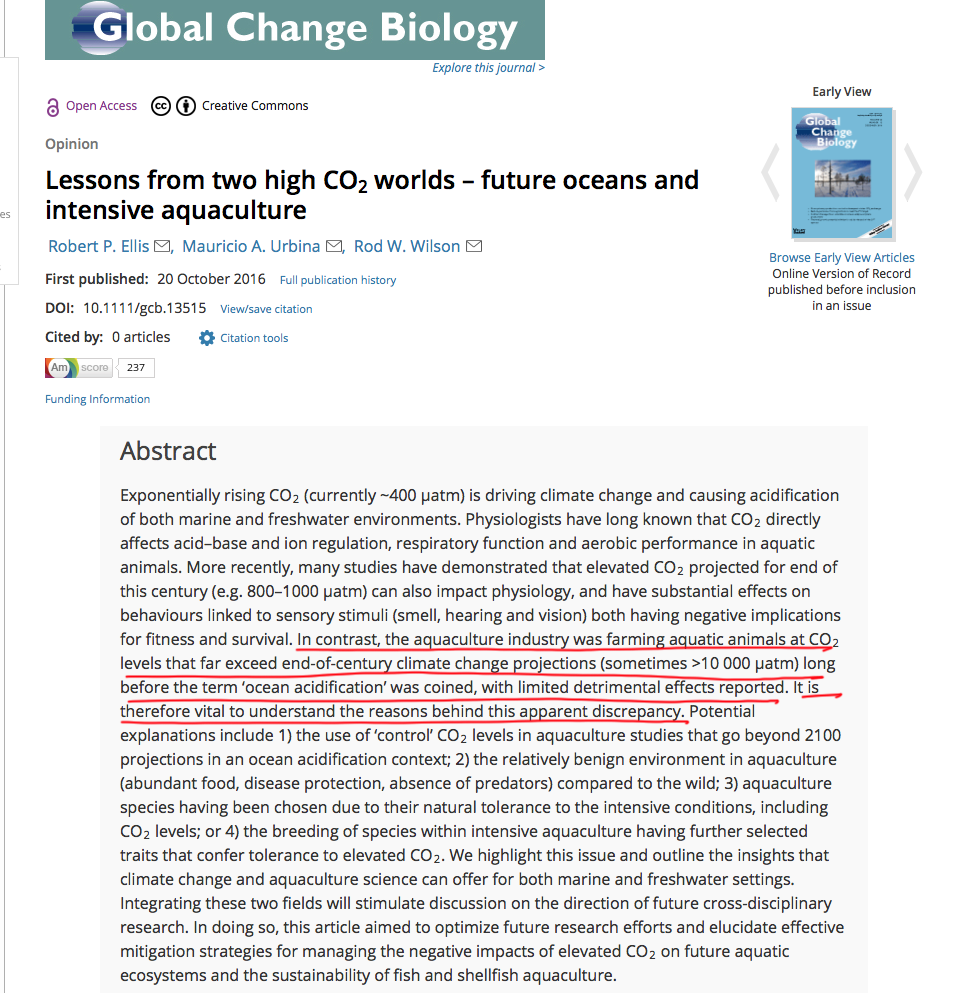” In contrast, the aquaculture industry was farming aquatic animals at CO2 levels that far exceed end-of-century climate change projections (sometimes >10 000 μatm) long before the term ‘ocean acidification’ was coined, with limited detrimental effects reported.”

Abstract below (note highlighted text), study here.

and yet the kill point for giant clams is a pH of 8.2 .. they’re most commonly found around acidic ocean vents in preferred pH ranges of 3.8 – 5.8 .. this is the biggest calcified mollusc known to exist.
– also a former aquaculturalist who studied chemistry, physics and botany
Having just finished an article on CO2, carbonate chemistry, CaCO3 supersaturation and how that relates to ocean acidification and being an aquaculturist for 4 decades who actually made a living raising all types of aquatic animals, this is a subject I fully understand (as well as any other researchers do).
Long-term exposure at 10,000 ppmv is a health risk to older fish, like broodstock. For short term meat production growout operations, it is fine.
However, even a small amount of ocean acidification will impact the Omega of the water ,which is the amount of supersaturation of CaCO3 (limestone) used to make shell for shellfish or corals is critical. For example, the production of oyster seed (baby oyster) crashed in all the hatcheries in the Pacific Northwest of the US from high CO2 in the water, but the levels were not very high. A small change makes a big difference for larval oysters. At that life stage, 80% of their body wt. is CaCO3 and they depend upon the supersaturation to cause the crystal growth without spending energy.
Tadchem, Tadchem, Tadchem is is never time to rethink assumptions, it is time to rethink the real world data to make it more in line with assumptions.
@Bob … you cannot have more neutral, it is either neutral or it is not. Either side of neutral is concentrations of alkalinity and acidity. “Less alkaline” is the correct term, then “neutral” (which is unlikely), and then “acidic” which is impossible in the oceans under the “influence” of CO2.
The “apparent discrepancy” means that the scientists’ expectations are inconsistent with the real world data. Time to rethink the assumptions.
It’s funny how the list of potential explanations includes everything except “our acidification premise is BS”. LoL, I’m sure farmer Bill chose to raise salmon because of their high tolerance to CO2.
The oceans are becoming slightly more neutral.
I remember when everything was blamed on “acid rain” caused by sulfur compounds. Now, you never hear about sulfur, all acid comes from CO2. I think a worthwhile study would be to check into the education of these climate “scientists.” Exactly what courses did they take in college and graduate school? Hard sciences like organic chemistry and physics? or “Environmental Studies” and Kumbaya? As one holding a chem degree, I recognized instantly that this acidification was nonsense, because plankton growth would quickly eat up any excess CO2 in the water. Further, the increased solar irradiation would push CO2 OUT of the water, not into it, as would any rising temperatures. If you’ve ever opened a warm bottle of soda, you know how CO2 does not like to stay dissolved in water, especially warm water.
What exactly are the educational requirements to be a “climate scientist?”
IT is past time “scientists”, or perhaps, more precisely, their journalists, stop using the word acidification as related to seawater. Ocean water is alkaline. It is mostly in the range pH 7.8 to 8.2. An honest discussion of possible, so far unproven, lowering of pH should use the term “less alkaline”, or something similar. The use of “acidic’ in relation to state of seawater is, at best, misleading, but is probably intended to be so, given the prejudicies of the greenies.
IT is past time “scientists”, or perhaps, more precisely, their journalists, stop using the word acidification as related to seawater. Ocean water is alkaline. It is mostly in the range pH 7.8 to 8.2. An honest discussion of possible, so far unproven, lowering of pH should use the term “less alkaline”, or something similar. The use of “acidic’ in relation to state of seawater is, at best, misleading, but is probably intended to be so, given the prejudicies of the greenies.